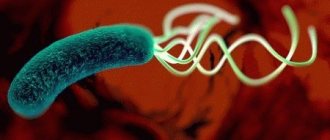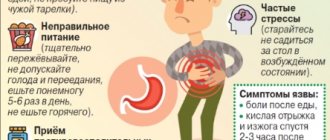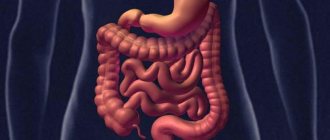Causes of dyspepsia in children
Changes in the functioning of the digestive system can occur at any time. The reasons for the formation of dyspepsia are both a complete transition to artificial feeding and complementary feeding with new ingredients. Dyspeptic syndrome occurs against the background of the unpreparedness of the enzymatic system to digest the introduced products.
Another negative factor is considered to be intestinal infections (salmonellosis, E. coli). In this case, severe pain occurs in the abdominal area, and this is noticeable even in very young children.
At an older age, the problem may arise due to overeating of one or another product not intended for baby food (smoked meats, sweet drinks, confectionery, fried gastronomic products).
Individual genetic characteristics of the anatomy of the gastrointestinal tract, nervous and enzymatic systems may also be the reasons for the frequent occurrence of problems with digestive processes.
Main types of dyspepsia
Dyspepsia can have a simple and toxic form.
Simple dyspepsia is accompanied by a disorder of the gastrointestinal tract.
With toxic dyspepsia, metabolism is disrupted.
With toxic dyspepsia, metabolism is disrupted. This type of disease can be accompanied by toxic poisoning of the body. Most often it develops against the background of otitis media, ARVI.
Toxic dyspepsia can result from simple dyspepsia. Harmful breakdown products accumulate in the body and are absorbed into the blood, causing toxic poisoning.
Depending on the nature of the disorder, the following types of dyspepsia are distinguished:
- fermentation
- putrid
- steatorrhea
Fermentative dyspepsia is caused by excess intake of carbohydrates into the body. As a result of fermentation, the baby develops diarrhea.
The putrefactive type of the disease is caused by excessive intake of protein products into the body. Protein breakdown products are absorbed into the intestinal walls and enter the blood. This is what causes the baby to develop diarrhea and vomiting.
Steatorrhea is caused by the baby's intake of too fatty foods. With this form of the disorder, the baby's stool becomes greasy and is difficult to wash off from the diaper.
Classification of pathology
No matter how experts try to classify this problem, it should be understood that this is not a diagnosis, but only a set of symptoms indicating pathology.
Dyspepsia is usually divided into several types:
- Nutritional dyspepsia in children. This disorder is associated with the consumption of new foods for which the enzymatic system has not yet prepared. This type is the most common during the period of rapid transition to complementary feeding.
- Toxic. It is observed with the development of opportunistic (E. coli) and pathogenic (Salmonella, Shigella) microflora, with a decrease in the resistance of the whole organism (decreased immunity). Toxic dyspepsia in young children occurs quickly and requires urgent intervention from a specialist.
- Fermentation. Microflora develops in the intestines, which releases gases (fermentation process). Fermentative dyspepsia in a child occurs due to the consumption of excessively carbohydrate foods. Newborns suffer from overfilling of the ventricle and untimely removal of its contents into the intestine.
- Putrid. Appears when the intestinal contents are overfilled and compacted (the so-called “blockage”). In this case, the chyme (intestinal contents) cannot be released in a timely manner and creates a favorable environment for the development of putrefactive microflora. Signs of putrefactive dyspepsia may include severe abdominal pain and foul-smelling stool.
- Organic. This is the name for pathology in established chronic gastrointestinal diseases (ulcers, pancreatitis, cholecystitis, etc.).
Causes
This type of dyspepsia develops when there is an excess of carbohydrates in the child’s diet.
More often the disease develops in infants. The main cause of their pathology is untimely or incorrectly introduced complementary foods. Violation of the recommended rules for preparing food for infants and tight swaddling contribute to the development of dyspepsia in a baby.
Children are more likely to develop dyspepsia:
- premature;
- with congenital metabolic disorders;
- with malnutrition (low body weight);
- patients with rickets.
Fermentative dyspepsia in older children develops due to insufficient digestion of carbohydrates.
This situation may arise:
- If the child has an unbalanced diet, eats foods containing large amounts of carbohydrates (especially coarse plant fiber in significant quantities). Fermentative dyspepsia is promoted by children consuming sweet carbonated drinks, energy drinks, kvass, grapes, legumes, and excessive indulgence in baked goods and sweets.
- Eating hastily, without thorough chewing, can contribute to the development of fermentative dyspepsia. When eating hastily, the breakdown of carbohydrates in the oral cavity under the influence of salivary amylase does not occur.
- With reduced secretion of gastric juice, the shell of plant fibers is not sufficiently digested. As a result, carbohydrates from plant foods remain inaccessible to the action of amylase, which is part of the secretion of the pancreas, and enzymes of the small intestine.
- Insufficient secretion of amylase by the pancreas due to its functional failure can also cause digestive disorders.
- Increased motility of the small intestine due to irritation by coarse plant fiber reduces the time for enzymatic action on carbohydrates, and they remain undigested.
Fermentation of undigested carbohydrates begins in the cecum and ileum. Later, fermentative microflora spreads through the small intestine to higher-lying sections. This is especially facilitated by insufficient secretion of gastric juice, as a result of which it does not have a bactericidal (destructive) effect on fermenting microorganisms.
Carbonated drinks can enhance fermentation. As a result of fermentation, a large amount of indole, skatole, organic acids and gases are formed, which have an irritating effect on the intestines, thereby stimulating its motility. The resulting products create favorable soil for the active proliferation of microbes.
As a result of irritation, a large volume of liquid contents of the intestines is released, and diarrhea with copious stools develops. The products formed during fermentation are absorbed and cause intoxication in the child’s body.
Particularly favorable conditions for fermentation in the intestines are created in the warm season or in countries with a hot climate. Under such conditions, the secretion of gastric juice and pancreatic secretion is reduced.
In addition, large amounts of liquid consumed further dilute the digestive juices, thereby reducing their enzymatic abilities. And drinking water or chilled drinks enhances the motility of the stomach and intestines.
Psycho-emotional experiences and stressful situations have an adverse effect on digestion.
Symptoms of dyspeptic symptoms in children
Simple dyspepsia in children is manifested by more frequent bowel movements, up to 4 times a day. There may be no complaints of abdominal pain or discomfort. This phenomenon is preceded by loss of appetite, belching, regurgitation, and lethargy. After 1-2 days, the stool becomes mushy or liquid.
Disorders in the younger group manifest themselves faster. They are characterized by the following manifestations:
- liquid feces will be observed already on the 3-4th act of defecation;
- preceded by colic discharge, the baby shakes its legs and cries, gases may be released with feces;
- the nature of the bowel movements varies from homogeneous to lump-like with admixtures of mucus, flakes, and blood;
- feces acquire different shades: from milky white to dark brown;
- upon examination, swelling can be detected in the area below the ribs;
- Listening to the abdomen easily reveals the sounds of splashing, squelching, and seething.
Nausea, vomiting, frequent, uncontrollable or intermittent - these are the symptoms that accompany the toxic form of the pathology. Sometimes you can clearly feel that the baby is hot. Antipyretic drugs should be prescribed by a doctor after a thorough examination.
Acute abdominal pain may alternate with aching pain. There is no appetite at all.
Dyspepsia in a young child is accompanied by symptoms of rapid satiety and stomach fullness, which entails refusal to eat.
Symptoms
Childhood fermentative dyspepsia has a mild course. In some cases, the child complains of the following symptoms:
bloating and rumbling in the stomach, a feeling of fluid transfusion inside the stomach, a feeling of heaviness and distension in the abdomen, painful sensations in the abdominal area, frequent bowel movements, sour belching, increased gas formation.
General signs of childhood fermentative dyspepsia include:
nausea, headaches, general malaise, irritability.
Diagnosis of fermentative dyspepsia in a child
Diagnosis of childhood fermentative dyspepsia begins with a medical examination. In this case, the specialist can detect signs of flatulence, rumbling in the stomach and characteristic splashing sounds in the intestinal area.
After the doctor has examined the child and collected data for the medical history, he writes out directions for laboratory and instrumental studies. Depending on the form and etiology of fermentative dyspepsia, this may be:
clinical blood test, biochemical blood test, scatological studies, gastric juice acidity test, endoscopy with mandatory biopsy, ultrasound examination of the abdominal organs, examination of the stomach contents for the presence of Helicobacter pylori, colonoscopy, radiography, computed tomography.
Most often, the diagnosis of this disease is limited to scatological examination. If digested or undigested fiber, organic acids, iodophilic flora and starch grains are found in the biomaterial, then this is a typical sign of fermentative dyspepsia.
Diagnosis and treatment of dyspepsia in children
Diagnosis requires an examination by a pediatrician with anamnesis and general laboratory tests. If necessary, additional tests are carried out: ultrasound, bacteriological culture of stool, examination of stool for helminth eggs and others.
Treatment of mild forms of dyspeptic disorder in children is carried out at home, on an outpatient basis. If intestinal infections (salmonella, etc.) are suspected, hospitalization is necessary.
Reviewing the diet is the basis of therapy. Check everything for freshness and good quality. Do not feed your baby foods that are not intended for baby food.
Infants immediately reduce the dose when feeding. To do this, 1-2 feedings are replaced with water or a glucose-salt mixture.
Mucous decoctions are introduced into the children's diet: oatmeal, jelly. The use of fermented milk products with live microflora (bifidobacteria and lactobacilli) also gives a positive effect.
Diagnosis and treatment of dyspepsia in children is carried out only under the supervision of a qualified specialist.
Therapy may include enzymatic preparations (pancreatin), sorbents (activated carbon), antispasmodics (to relieve pain), antibiotics (to destroy putrefactive microflora).
Treatment of indigestion in children
Treatment of dyspepsia is associated with eliminating the causes and symptoms. Causes are eliminated through diet, and symptoms through medications. Timely normalization of the functioning of the gastrointestinal tract is necessary due to the fact that any disturbances in the digestive system lead to serious complications.
Drugs used for indigestion, pictured
If the doctor has confirmed the presence of functional dyspepsia, then the child needs to be given rest, given plenty of fluids, and put on a diet. If necessary, the doctor prescribes antispasmodics to relieve abdominal pain, prokinetics to normalize gastric motility, and enzymes to improve digestive function.
strict diet; unbalanced diet; hypersecretion of hydrochloric acid; eating foods rich in carbohydrates; disturbances in the functioning of the chewing apparatus; quick snacks; weak secretion of gastric juice; decrease in pancreatic amylase levels; increased peristalsis of the small intestine; taking potent medications; psycho-emotional stress.
In the absence of proper drug treatment, the following complications may occur: the transition of an acute form of fermentative dyspepsia to a chronic form, the development of diseases of the gastrointestinal tract, gastric bleeding, dystrophic processes, weight loss or underweight, developmental delay.
Causes
Timely treatment, adherence to diet and nutrition, treatment of concomitant diseases - these are the necessary conditions for recovery from fermentative dyspepsia. If any unusual symptoms appear, as well as if existing ones worsen, immediate consultation with a specialist is necessary.
Most often, the cause of this disease is non-compliance with the water-tea diet, which is prescribed for small children, or simply insufficient fluid intake by the baby. Toxic dyspepsia often affects premature babies and children suffering from rickets and dystrophy.
Diet
Treatment of pathology cannot be carried out without monitoring the quality and quantity of food consumed. The frequency of doses and the composition of the diet is determined by the doctor after examination and an accurate diagnosis.
Eliminate fried, fatty, confectionery and factory-made semi-finished products from the menu. The diet should contain natural fermented milk products, cereals, vegetables and fruits. Give preference to lean varieties of meat and fish.
The diet, as a rule, lasts longer than the treatment, and it is necessary to transfer the patient to a general table only as directed by the doctor.
Treatment
What can you do?
After a child is diagnosed with fermentative dyspepsia, it is necessary to limit the intake of foods containing large amounts of carbohydrates. If the newborn is breastfed, then the nursing mother should also avoid the above foods. In doing so, she must comply with the following recommendations:
strictly observe the feeding regimen, control the amount of food the baby consumes, massage the baby’s belly, carry the baby in an upright position after each feeding, do not swaddle the baby, carefully monitor the condition of the newborn.
What does a doctor do?
Usually, when treating fermentative dyspepsia in infants, it is enough to follow the above rules. Drug treatment is required if symptoms do not go away even after following a feeding regimen. If indigestion is caused by more serious pathologies, then the doctor should prescribe medications to eliminate the underlying disease. Only after this is symptomatic treatment prescribed, which includes:
Prevention
In order to reduce the risk of developing this pathology in a child, it is necessary to carefully monitor his diet. The following products should not be included in the children's menu:
carbonated drinks, alcoholic drinks, spicy and fried foods, too salty and sweet foods, foods high in carbohydrates.
The child's nutrition must be correct and balanced. Moderate physical activity, therapeutic exercises and an active lifestyle are recommended. Don't forget to visit your pediatrician regularly.
Diseases of the gastrointestinal tract occupy a leading position in the list of diseases for children and often lead to unpleasant consequences. Their number increases the younger the child is. The largest category of diseases of the digestive system is dyspepsia in infants - functional nutritional disorders.
Acute disorders of the stomach or intestines are a common pathology of infants, in which, against the background of the clinical picture of the digestive system, signs of deterioration in the general condition, metabolism, and coordinated functioning of all organs and systems appear. Such disorders can provoke serious disruptions in the body's metabolism.
Symptoms of the disease
Excessive amounts of food, frequent feeding, early introduction of complementary foods, and excess flour in a child’s daily menu can cause disruption of the body’s digestive function.
Dyspepsia in newborns is accompanied by the following symptoms:
- weight loss,
- stomach pain,
- indigestion,
- vomit,
- Difficulty in emptying or the stool, on the contrary, becomes liquid, may also bother you.
In many cases, the factors that precede the onset of signs of pathology remain unidentified.
When breastfeeding, the baby loses weight, has frequent vomiting and upset bowel movements. Treatment with medications and other means does not have the desired effect. The child continues to lose weight, gradually becoming skeletal, and the number of bowel movements does not stabilize. Along with this, no characteristic features of rickets in infants were identified.










